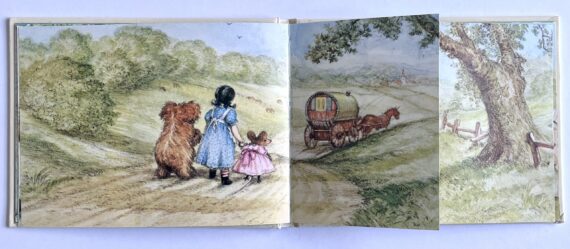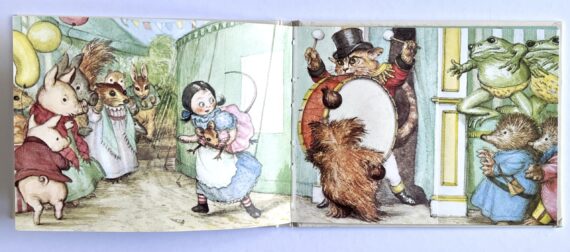The Midnight Adventures of Kelly, Dot, and Esmeralda
John S. Goodall
John S. Goodall (1908-1996), a favourite illustrator of mine, was a respected and literate British artist of the 20th century. He illustrated for magazines, such as the Radio Times; for books (including the ‘Miss Read’ series); and for advertising commissions.
He also specialised in the wordless book format and created many books that showed scenes from Victorian and Edwardian life, such as Victorians Abroad (1980) and An Edwardian Christmas (1977). He is particularly famed for his Paddy Pork series of wordless comedy adventures (see Paddy Finds a Job), the first of which, The Adventures of Paddy Pork (1968) won the Boston Globe-Horn Book Award in 1969.
The Midnight Adventures of Kelly, Dot, and Esmeralda has, like many of Goodall’s other wordless books, a small landscape format, with half pages inserted between full spreads. These act like mini animations and show new plot developments that move the story along. True to its title, this book is a real adventure story, packed with incident on every page and intricately plotted by Goodall.

The story opens with a group of toys asleep on a mantelpiece in a child’s nursery. When midnight strikes, they awake. This trope of inanimate objects becoming sentient (if not necessarily able to move independently) at night is a familiar one. For instance it appears in Hans Christian Andersen’s story ‘The Steadfast Tin Soldier’ (1838), where, after the humans have gone to bed, we are told: ‘Now was the time for the toys to play; they amused themselves with paying visits, fighting battles, and giving balls.’ Likewise the concept of midnight – or, as in the case of Philippa Pearce’s Tom’s Midnight Garden (1958), thirteen o’clock – being the witching hour where magic can happen is also familiar.
In this book, the inanimate objects are classic toys: first Kelly, a Koala bear, and Dot, a doll. Later they are joined by a tiny toy mouse, Esmeralda. She lives in the doll’s house that sits on the mantelpiece alongside a ball and some books.
A mouse in a doll’s house brings to mind Hunca Munca of Beatrix Potter’s The Tale of Two Bad Mice (1904), and the doll’s house in The Midnight Adventures of Kelly, Dot, and Esmeralda almost matches (apart from the chimney) Potter’s description of the doll’s house in that book: ‘…it was red brick with white windows, and it had real muslin curtains and a front door and a chimney.’ Here, though, Esmeralda is an inversion of Hunca Munca, as she is a toy rather than a real mouse, and a respectable one at that, delighted to be serving tea to her friends in her neat and tidy sitting room, rather than destroying the things around her, as Hunca Munca and her husband Tom Thumb do in Potter’s story (though they do redeem themselves in the end).

After tea in the doll’s house, the three friends step inside the frame of a picture on the wall that shows an appealing scene of a gently flowing river, grassy bank and boat.
Here again there are playful visual hints of another well-known story. The concept of climbing through a frame into a magical world is used in Lewis Carroll’s Through the Looking-Glass and What Alice Found There (1871), where Alice steps through a looking-glass over a mantelpiece and finds herself in a reflected world, initially similar to her own home. (Years later, in 1988, Posy Simmonds would use the idea of a child climbing through a picture frame in her delightful graphic novel Lulu and the Flying Babies).
Dot’s puffed-sleeve dress, worn with a white pinafore on top and striped stockings underneath, also has intertextual echoes of John Tenniel’s drawings of Alice in Through the Looking-Glass and What Alice Found There. Even the boat trip that Dot and her friends later take along the river recalls the 4 July 1862 boat trip that Carroll (real name Charles Dodgson) took with Alice Liddell and her sisters when he first conceived the story that eventually became Alice’s Adventures in Wonderland (1865).
Described as a ‘golden afternoon’ in the poem that prefaces that novel, it indicates a beautiful day, just like the one in this book where Dot and her friends are taking a trip in the boat. But in their case the boat tips over and the toys become drenched. Goodall cleverly uses the half-page technique to instil a sense of anticipation of what’s to come. When the half-page is on the right, the stones can be seen ahead; when the half-page is turned to the left, the boat is seen crashing onto them (see below).


Luckily the toys are unhurt and dry off on the river bank, where a hedgehog comes to join them. He takes them to his house for some restorative soup, and after the meal the toys hitch a ride on the back of a painted gypsy caravan.
There is a reminder here of Toad’s horse-drawn caravan in Kenneth Grahame’s The Wind in the Willows (1908), and the whole bucolic scene of the old-fashioned caravan meandering through the rolling hills of beautiful English countryside is hugely nostalgic.

Soon the gypsy caravan passes some tents at a fairground and the three friends jump off to investigate them. Kelly heads to the coconut shy, but unfortunately the poor little mouse is abducted by a large cat and is whisked off to a tent, where she is forced to perform a circus act with some frogs.

Fortunately Kelly saves the day. He has won two coconuts and throws these at the band’s fearsome drummer cat to distract him. Meanwhile Dot rescues Esmeralda.

The toys run away fast, but the cat is in close pursuit. Fortunately they make it to the river in time to climb back into their boat and return to the safety of the nursery mantelpiece through the picture frame.

They rush back to their places and, by the time the clock is showing just after 1am, they have settled down to sleep again.
But will the child whose nursery it is notice that the tiny mouse is now in a different place from where it was left the night before? (And will the child reader spot this, too?)

For such a tiny artefact, this book offers so much richness. Goodall’s delicate watercolour illustrations in soft greens and blues are so strong on emotion and detail that both adults and children should enjoy this story of adventure, potential danger and supportive friendship. The adults are also likely to appreciate how skilfully it is told.